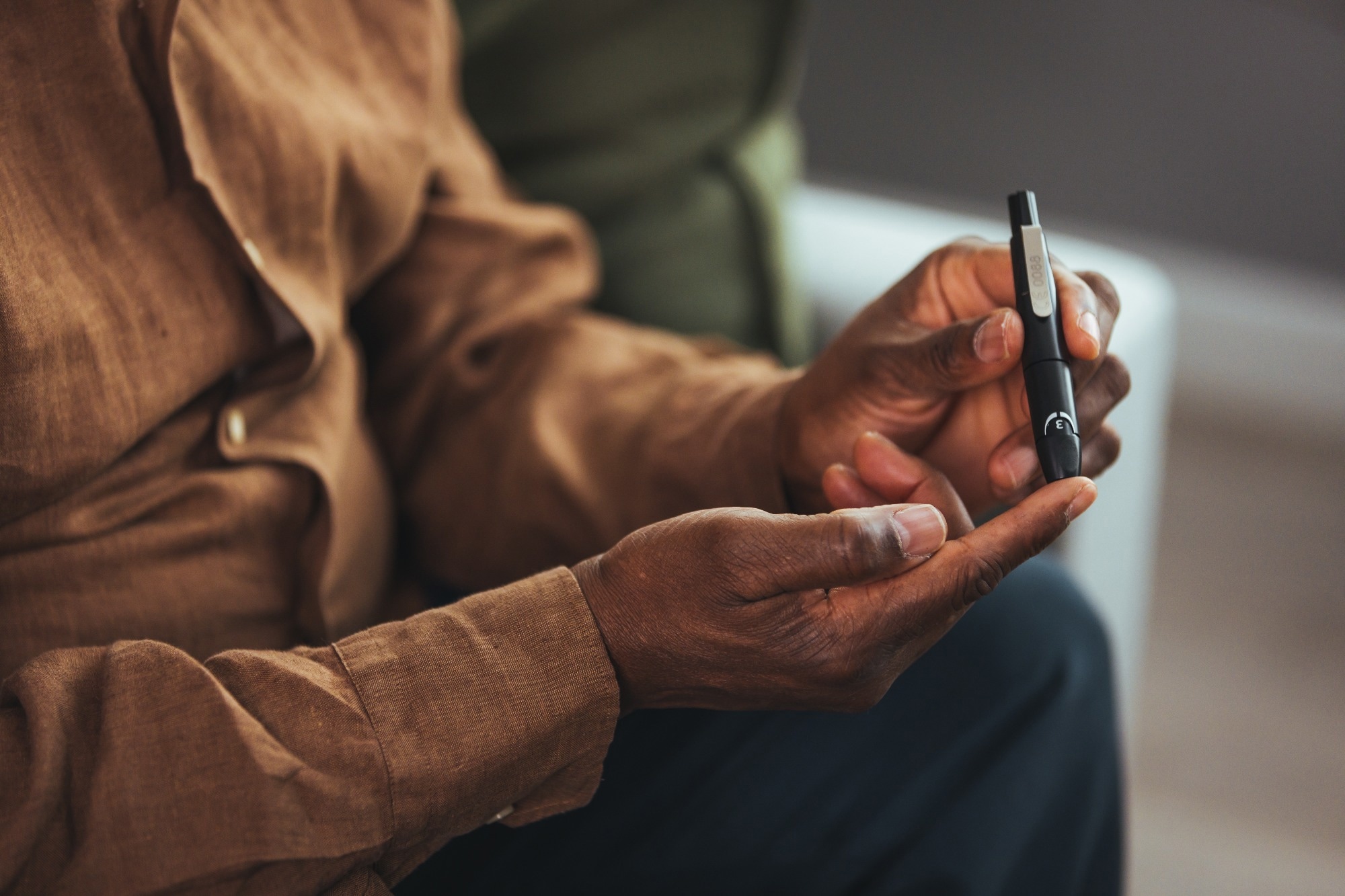Diabetes and adiposity have been linked to musculoskeletal disorders; however, the exact mechanisms behind these connections remain unclear. Observational studies have reported associations between type 1 and type 2 diabetes and fibroproliferative upper limb musculoskeletal conditions such as limited joint mobility. Diabetic cheiroarthropathies are associated with age, sex, diabetes duration, and glycated hemoglobin (HbA1c) but not body mass index (BMI). The causal effects of adiposity on the trigger finger, frozen shoulder, and hyperglycemia on musculoskeletal pathologies remain unproven.
 Study: Hyperglycaemia is a causal risk factor for upper limb pathologies. Image Credit: Dragana Gordic / Shutterstock
Study: Hyperglycaemia is a causal risk factor for upper limb pathologies. Image Credit: Dragana Gordic / Shutterstock
About the study
In the present study, researchers examined the association between long-term hyperglycemia and adiposity in Europeans to determine the causality of these conditions.
The UK Biobank, including 379,708 Europeans, underwent Mendelian randomization (MR) to examine the impact of prolonged hyperglycemia and obesity on conditions such as Dupuytren's disease, frozen shoulder, trigger finger, and carpal tunnel syndrome. The team also conducted single-gene Mendelian randomization using rare glucokinase (GCK) gene variants. They investigated whether adiposity and glycemia increase the risk of fibroproliferative pathological conditions affecting the upper limb.
The researchers measured glycemia using blood glucose and HbA1c values and adiposity using waist-hip ratio (WHR), body fat percentage (BFP), and BMI. They excluded individuals with missing data on the variables from the analysis. They diagnosed the four pathologies using the Operating Procedure Codes Supplement 4 (OPCS4), the International Classification of Diseases, the tenth revision (ICD-10) codes, and the Hospital Episode Statistics (HES) definitions.
The team used the Meta-Analysis of Glucose and Insulin-related Traits Consortium (MAGIC) data to obtain genetic instruments for glycated hemoglobin. They utilized 51 single-nucleotide polymorphisms (SNPs) to isolate glycemic effects for genetic HbA1c instruments and 124 SNPs to affect glycated hemoglobin through non-glycemic pathways. They also tested 130 single-nucleotide polymorphisms for fasting-type blood glucose.
The researchers extracted genetic variants for body mass index and genetic risk scores (GRS) from a genome-wide association study (GWAS) conducted in 2015, including 339,224 participants. They used two GRS and variant sets for the waist-hip ratio obtained from meta-analytical research on 694,649 Europeans. For BFP, they used 36 genetic variants for favorable and 39 for unfavorable adiposity. The team determined the association between musculoskeletal conditions and exposure traits using logistic regressions, one-sample MR, and GWAS.
Results
The MR analysis showed the causal effects of long-term hyperglycemia on upper-limb pathological conditions. An increase of 10 mmol/mol in genetically estimated glycated hemoglobin was related to frozen shoulder, Dupuytren's disease, carpal tunnel syndrome, and trigger finger, with ORs of 1.5, 1.2, 1.2, and 1.3, respectively. GCK mutation carriers increased the odds of frozen shoulder (OR, 7.2) and carpal tunnel syndrome (OR, 2.9). A 5.0 kg/m2 rise in genetically estimated BMI showed positive associations with carpal tunnel syndrome (OR, 1.1) and negative associations with Dupuytren's disease (OR, 0.9). Carpal tunnel syndrome (OR, 1.6) and trigger finger (OR, 2.0) were associated with a genetically predicted unfavorable obesity increase of 1.0 standard deviations of body fat.
All four conditions were related to HbA1c, blood glucose, and adiposity-related traits. All conditions were associated with smoking, with Dupuytren's disease strongly related to alcohol consumption, consistent with general practitioner (GP) and self-reported data. MR findings supported the observational associations for HbA1c using single-nucleotide polymorphisms acting on glycemic pathways. There were consistent associations between blood glucose and all four conditions in the MR and observational analyses. The relationships between HbA1c, blood glucose, and BMI were non-linear. The causal estimations for glycated hemoglobin equated to odds ratios for every 10 mmol per mol increase in HbA1c of 1.5, 1.3, 1.2, and 1.2 for frozen shoulder, trigger finger, carpal tunnel syndrome, and Dupuytren's disease, respectively.
The meta-analysis with FinnGen showed pathogenic GCK mutations related to all four conditions. These mutations were strongly related to increases in HbA1c and glucose but not adiposity-associated traits, alcohol, or smoking. The team did not observe the association of a frozen shoulder with WHR and BMI in the MR study. The negative associations of body mass index with Dupuytren's disease were consistent in Mendelian randomization but not with WHR.
Trigger finger was related to WHR and BMI; however, only the waist-hip ratio association showed consistency with the observational effects. The MR analysis showed attenuated associations between carpal tunnel syndrome and BMI. BFP negatively influenced Dupuytren's disease risk and positively influenced carpal tunnel syndrome risk. Dupuytren's disease was negatively associated with BMI.
Overall, the study findings highlighted long-term hyperglycemia as a significant factor in the incidence of upper-limb musculoskeletal conditions. Elevated blood glucose levels increase the risk of Dupuytren's disease, frozen shoulder, trigger finger, and carpal tunnel syndrome. BMI increases the risk of carpal tunnel syndrome but prevents Dupuytren's disease. Clinicians treating diabetic individuals, especially those with GCK mutation carriers, must consider these complications. Adiposity has mixed evidence, with all conditions associated with BMI and WHR.